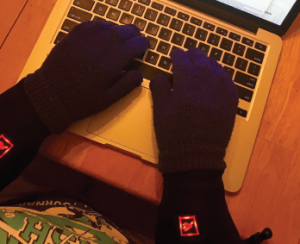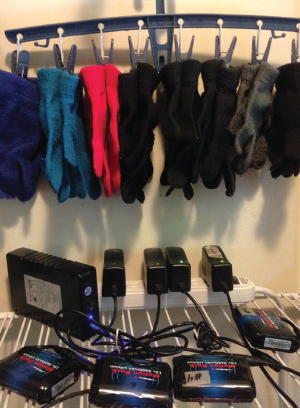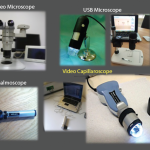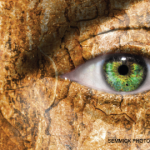The safety and effectiveness of continuous heated glove use depend on certain patient characteristics, digital skin integrity and glove choice. First and foremost, the patient should be cognitively intact and be able to detect superficial heat changes in the hands and digits. Also, she should be physically capable of turning the gloves on and off and adjusting the temperature settings to prevent overheating. If a digital ulcer is present, its origin and status should be determined and appropriate wound care and treatment prescribed for the type of lesion.5

Figure 2: Heated gloves on a “cool” (71ºF) summer morning halt Raynaud’s episodes and enable more comfortable typing.
My ischemic ulcer responded well to heated glove use, and topical medications were not needed. However, the effect of continuous local heat on other types of digital lesions (e.g., erupted subcutaneous calcinosis, traumatic ulcers, gangrene) and topical medications has not been studied; thus, clinical judgment and close monitoring are needed to determine appropriateness of this intervention.
Along with patient characteristics and digital skin status, glove choice is important. Most heated gloves, including the battery-operated heated gloves mentioned in this article and the October article, are not regulated medical devices. Patient variability, stage of scleroderma, nature of digital ulcers and brand of glove may affect the results.
Heated gloves should (see Figures 2 and 3):
- Provide heat all the way to the fingertips;
- Have adjustable heat settings;
- Be lightweight, washable and durable to tolerate wear and tear of daily donning and doffing;
- Allow adequate fine motor function;
- Come with battery chargers and have wall/car adapters available to supplement batteries; and
- Come with good customer service support.
These are just a few observations, and the list is by no means all inclusive. The important point is that the gloves meet the needs, abilities and lifestyle of the individual.

Figure 3: My battery-charging station and knit-glove collection. Knit gloves worn over the heated glove (liners) provide extra protection for the fingertips and keep the gloves clean.
If daily, continuous use of heated gloves can help a patient in the later stages of dSSc (as I am), could it decrease pain and delay sclerodactyly in the earlier stages of the disease? I think it’s worth investigating.
I met a 19-year-old young woman who was 18 months post-dSSc diagnosis and presented with microstomia, edematous fingers and healed ulcers, but had not yet developed disfiguring flexion contractures. Her mother had bought her heated gloves after seeing mine, and we three discussed the rationale and precautions for continuous glove use (see sidebar, right), as well as the social or cosmetic aspect. She said the heated gloves did make her hands feel and work better, but she wore them only when she needed them: when her hands were cold or the Raynaud’s pain was too much. I wonder what would happen if she dared to wear them continuously?
All 4 types of pain—stemming from Raynaud’s episodes, acro-osteolysis, digital ulcers & swelling—are decreased or completely relieved while I wear battery-operated heated gloves.
While researchers work to find a cure for SSc and more effective pharmaceutical agents for Raynaud’s, we patients can do our part: Avoid cold, and increase circulation to our fingers. Ultimately, it is up to the clinician and patient to decide what is the safest, most feasible method to alleviate pain and protect and preserve hand integrity and function in the individual.


